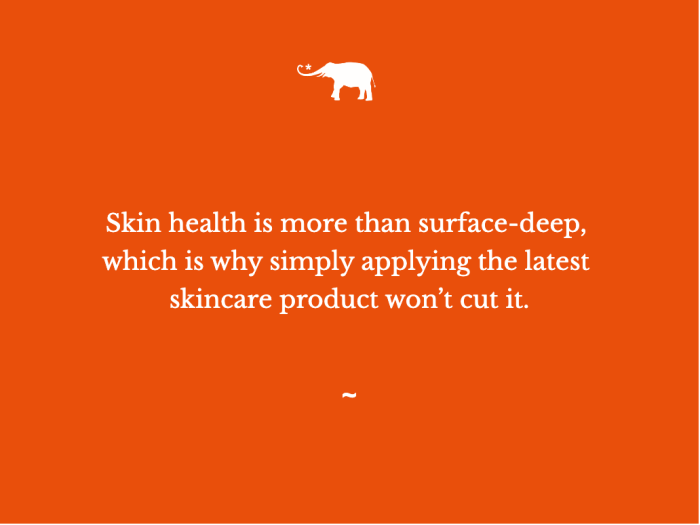While no one particularly relishes the idea of millions of microorganisms crawling around, the truth is that much of our skin health is determined by our microbiome. The skin microbiome is made up of healthy skin bacteria and fungi, and it’s our largest organ’s natural defense system. When the skin biome is thriving, our bodies are healthier, our bones and musculature are safe, and our skin is hydrated and glowing.
The skin comprises three separate layers: the epidermis (the top layer), the dermis (or middle layer), and the hypodermis (the bottom layer). The epidermis is our body’s first-line defense; it replaces itself at a staggering speed of 40,000 skin cells every day. The dermis is the thickest layer and provides the structure of the skin. And for all the skincare lovers out there, the dermis is where collagen and elastin are found, which keep the skin flexible. Lastly, the hypodermis contains necessary layers of fat while also housing nerves and blood vessels, connecting the skin with the rest of the body.
Topicals Aren’t Always the Answer
Much of the skincare industry focuses on topical ointments and lotions to treat skin problems, citing that topicals are convenient and less invasive than other treatments. Topical treatments have more manageable side effects than systemic treatments and offer a wide range of options in terms of consistency, formulation, price, etc.
However, topicals aren’t always the answer. Effective topical usage is about providing balance and complementary therapy: There is no need to treat one symptom when it might cause other issues. For example, popular toners can restore pH balance but also strip the skin of its natural oils (which eventually alter the skin’s pH).
An example of this dual effect is bakuchiol, a plant-based derivative purported to be a possible retinol alternative. Bakuchiol has been reported to have similar efficacy as retinol but without the irritation that often comes with retinol use. Yet, bakuchiol is also intensely antimicrobial. While manufacturers could see excellent results with skin cell regeneration, it can also cause dysbiosis or an imbalance of the skin microbiome.
Understanding Bacteria’s Place Within the Biome
The skin microbiome is home to a wide variety of healthy skin bacteria, fungi, archaea, and viruses that live in and on our bodies. As counterintuitive as it might seem, it’s crucial to have good bacteria for healthy skin. While harmful bacteria on the skin are indeed associated with a number of skin conditions, context is everything. How bacteria interact with the skin depends upon the environment. All microbes, the good and the bad, can act very differently depending on their environment.
We must realize that we always have billions of microbes on the skin and that the substances they produce very much depend on the environment we create for them. If something is added to the skin that the bacteria do not like, then the microbe may start producing substances to protect itself, which might lead to an issue.
How to Restore Skin Microbiome
While topicals will always have their place in skincare, understanding and maintaining the skin biome balance is more effective than any trendy treatment or buzzy ingredient. Here are three essential concepts for enhancing the skin’s natural defenses.
1. Not all skin microbiomes are created equal.
Although bacteria make up the majority of microbes on the skin, they’re not the only ones present. As humans, we also play host to a variety of fungi and even viruses — all of which interact with us and each other to produce a balanced ecosystem. There are even interactions amongst bacteria, as bacteria communicate using different molecules, such as antimicrobial peptides that are used to claim certain niches in the skin. For instance, C. acnes makes anti-staph antimicrobial molecules, while Staphylococcus produces anti-C. acnes molecules.
In our mother’s womb and when we’re born, these bacteria establish a territory or perimeter. Perimeters are created by growing a biofilm of specific molecules, such as antibacterial molecules, allowing these bacteria to maintain their space. Theoretically, this advanced zoning system works well until these microbes try to infiltrate another territory, secreting molecules that can cause irritation and microbial imbalance and potentially contribute to issues like acne and eczema.
2. Formulations matter.
The formulation of a product, its ingredients, and the formula’s strength determine its safety and efficacy. Let’s consider skincare a bit like food: Just because a snack has an ingredient we need doesn’t mean the snack is good for our bodies. A candy bar loaded with sugar and unhealthy fats isn’t made healthy by adding a multivitamin to it (though it wouldn’t make it worse).
The same holds true for topical formulations. If a great, skin-healthy ingredient is in a topical but the rest of the formulation is “junk food,” then it might not be the best for the skin. Unfortunately, we only can see the ingredients of the products we use, not the amounts. The levels of ingredients are important and can be the difference between a great topical product and one that might not help at all … or, worse, cause issues. This is why looking for products with fewer ingredients is always better.
3. Choose nonaggressive cleansers.
While cleansing the skin can be an essential part of a skincare regimen, cleansing the skin does not mean stripping it of essential elements.
Foaming cleansers are popular skincare products sold by hundreds of brands. However, decades ago, researchers discovered the surfactants that cause soaps to foam were incredibly irritating to the skin. In response to these findings, manufacturers removed this ingredient from their products, resulting in a significant decline in sales. Consumers equated foaminess with cleansing ability. So, many brands incorporated these foaming ingredients back into their formulations.
Aggressive cleansing products can create a whole host of problems by removing essential skin oils and drying out the skin. When we strip the skin of oils, we remove the environment from the skin biome that keeps it balanced, leading to changes in the skin microflora (bacteria) and dysbiosis (microbiome imbalance). When this happens, the skin’s barrier, our natural defense from pathogens, will likely also be damaged. So, look for gentle cleansers with very little surfactants. Non-foaming cleansers best preserve the skin biome.
To ensure our skin is healthy, we must understand the skin microbiome. Then, we can learn more about skincare product formulations and choose the correct product for our specific microbiomes. Always remember that simple is better when it comes to skin. By following this advice, you can ensure healthier and better-looking skin.









Read 0 comments and reply